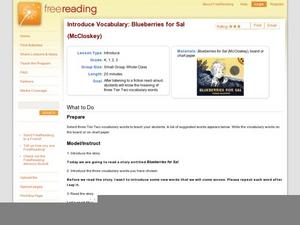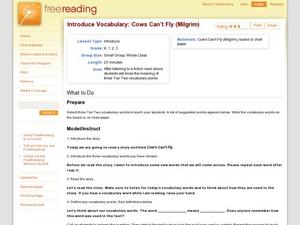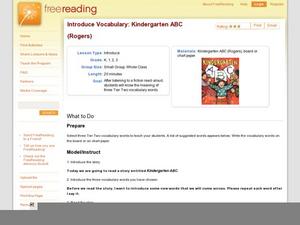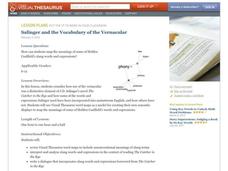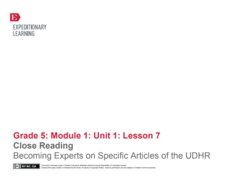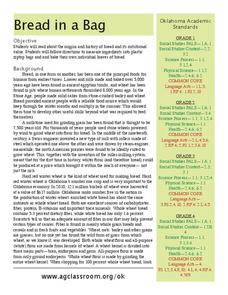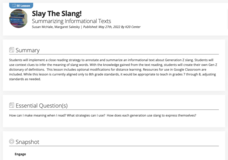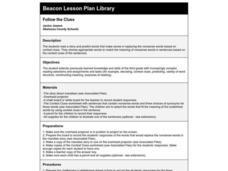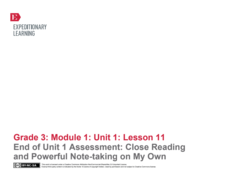Curated OER
Introduce Vocabulary: Blueberries for Sal (McCloskey)
Take your budding readers on a literary trip to pick blueberries as they learn vocabulary from Robert McClosky's book, Blueberries for Sal. By pre-teaching the words pupils are prepared to raise their hands when they hear...
Curated OER
Introduce Vocabulary: Cows Can't Fly (Milgrim)
Cows can't fly, can they? David Milgrim's whimsical story makes vocabulary fun! Although this strategy can be used with any text, using Cows Can't Fly will be a breeze with this outline. Pupils are ready to raise their...
Curated OER
Introduce Vocabulary: Cross a Bridge (Hunter)
What does suspension mean? Learn this and other bridge-related vocabulary as scholars listen to Ryan Ann Hunter's nonfiction book, Cross a Bridge. This strategy can be applied to any book. Before reading, acquaint pupils...
Curated OER
Introduce Vocabulary: Dinosaur Bones (Barner)
Dig into some prehistoric vocabulary in Bob Barner's informative book Dinosaur Bones. This works best if you introduce the primitive words before reading the story. These are the focus terms in the text: ancient, climate, extinct,...
Curated OER
Introduce Vocabulary: Gregory, the Terrible Eater (Sharmat)
Help budding readers learn words like develop and revolting as they listen to you read Mitchell Sharmant's Gregory, the Terrible Eater. Get the new vocabulary rolling before reading it aloud so youngsters can raise a...
Curated OER
Introduce Vocabulary: Kindergarten ABC (Rogers)
As kindergartners are learning the alphabet, expand their vocabulary in the process using Jacqueline Rogers' book Kindergarten ABC. Each page features a letter and various objects for scholars to locate in the picture, and...
Curated OER
Introduce: Comprehension Strategy: Comprehension Monitoring
Help readers develop awareness of comprehension issues and employ tools for better understanding. The best way to begin this strategy is to model it through a think aloud. Choose a book scholars will also be reading, preferably one they...
Curated OER
Salinger and the Vocabulary of the Vernacular
Writers explore vocabulary and expressions used in the English language. They use visual word maps to become aware of the different uses of words which will allow them to more readily interpret texts. Then they listen to/read excerpts...
EngageNY
Close Reading: Unpacking Specific Articles of the UDHR
Lesson 6 of this extensive unit finally has your class begin to work their way through specific articles from the text of the Universal Declaration of Human Rights (UDHR). Before examining the rights actually detailed in the...
Curated OER
Introduce: Cause and Effect
Introduce beginning readers to cause and effect in a story by exploring it together. Learners make predictions about a book based on its cover, title, and a brief flip through the pages. They listen to an explanation of cause and...
EngageNY
Close Reading: Becoming Experts on Specific Articles of the UDHR
A continuation of the previous lesson plan, which is part of a larger group of lessons on human rights (see additional materials). Here, in Lesson 7, your class will explore more articles from the Universal Declaration of Human Rights....
Curated OER
Using Initial Sounds and Picture Clues to Read Unknown Words
Kindergarteners read the bold words that are unknown by using the strategies of initial sound and picture clues. They meet individually with their teacher in order to assess this concept. Excellent resource!
Curated OER
Predicting Actions
Analyze and predict a character's actions in a text by reading the book Julius, Baby of the World and discussing the character's personality. Individuals use a character action chart to record their actions throughout the story, and then...
Curated OER
Bread in a Bag
Could the history of bread really be interesting? Yes, it could! An informational text gives scholars wheat production background from 8,000 years ago, discussing different types of bread and the current industry in Oklahoma. Learners...
K20 LEARN
Slay the Slang! Summarizing Informational Texts
Middle schoolers get hip to the jive with a lesson plan about slang. They closely examine examples of slang and use context clues to infer the meaning of the terms. Groups read and summarize an article about a teacher who created a Gen Z...
EngageNY
Building Background Knowledge: Close Reading Part 2 of “Shrouded in Myth”
That was a good talk. Scholars learn about how to conduct a good discussion. They use chart paper and markers to record and discuss expectations for members when working in a group. They then take a look at vocabulary...
Curated OER
Context Clues
Students develop vocabulary using pre -reading strategies. In this language arts lesson plan, students discuss the intended message from observing a picture. Additionally, students explore guessing the covered word within a text.
Curated OER
Applying Decoding, Vocabulary, and During Reading Strategies
Apply reading strategies to boost phonemic awareness. While reading a provided informational text, learners use decoding, vocabulary, and a graphic organizer to strengthen their overall reading ability. Handouts and the reading passage...
Curated OER
Comprehension Strategy Instruction: Questioning
Providing learners with a solid armory of reading strategies is a good way to help them build better reading comprehension. The teacher will model how to use a questioning checklist to better understand what she is reading. Pupils will...
Vocabulary A-Z
5-Day Vocabulary Teaching Plan
Reinforce important reading skills with a set of vocabulary lesson plans. Middle schoolers complete sentences, play word games, finish analogies, and build their growing vocabulary with a packet of helpful and applicable graphic organizers.
Learning for Justice
Mary Church Terrell
Excerpts from an 1898 speech by civil rights activist Mary Church Terrell offers young scholars an opportunity to investigate how Black American women fought for civil rights long before Rosa Parks and the civil rights movement of the...
Curated OER
Follow the Clues
Students read a story and predict words that make sense in replacing the nonsense words based on context clues. Students choose appropriate words that will match the meanings of the nonsense words.
Brigham Young University
Rosencrantz and Guildenstern Are Dead: Word Squares
Encourage your class to use a variety of strategies to learn and retain vocabulary words. The plan suggests that near the beginning of your reading of Rosencrantz and Guildenstern Are Dead pupils should find words in the text that are...
EngageNY
End of Unit 1 Assessment: Close Reading and Powerful Note-Taking on My Own
As the final lesson plan in a larger beginning-of-the-year unit to establish routines and teach close reading skills, this plan is designed as an assessment piece. Using the story, The Librarian of Basra, learners independently...
